Ohio State dominates Oregon, 41-21, and advances to the College Football Playoff semifinals.
Well, football is back! And with that, I think it’s time to resume the military history series after a couple of week’s break. Now that we’ve wrapped up the French Revolutionary and Napoleonic Wars, it’s time to move onto the next request- a discussion of the various operations of the 37th Infantry Division in World War II. Why the 37th Division? It’s the Buckeye Division, of course. We’ll look at some of the battles closely, some of them from a broader perspective. We’ll start with the divisions first real action of the war, the Battle of Munda Point on New Georgia.
As usual, if you’re interested in what’s going on here, feel free to comment below. Also, check out the archive if you want to read some of the other military history that’s gone on here before by clicking here. Also, there aren’t as many battles here as there are in the Napoleonic Wars, so feel free to get the next request in- otherwise, I’ll just do whatever I feel like.
The War in the South Pacific
When war erupted in the Pacific in late 1941, the Japanese launched a series of attacks across the Pacific while the US attempted to recover from the surprise attack. While the largest operation went to take the island of Luzon and Manila Bay, a number of attacks sought out a variety of American, Dutch and Australian bases across the Pacific. One of those, targeted in January of 1942, was the small Australian port of Rabaul on the island of New Britain. Along with Lae on the island of New Guinea, the Japanese would try to use these bases to close off access to Australia, perhaps prepatory to an invasion later.
Japan followed up its success in the area by moving down the Solomon Island chain, capturing most of the islands to build bases on them as well. However, the Owen Stanley Mountains, a series of steep ridges that cuts the island of New Guinea nearly in half across its width, proved pretty well impassible to Japanese attacks across the land. This allowed the Australians to build up Port Moresby, on the southern coast of the island, into a large base as well, which threatened Lae by air. In order to take Port Moresby, the Japanese Navy mounted a large operation in May, 1942. Forewarned by codebreakers, the US Navy met the Japanese Navy in the Battle of Coral Sea. While the US suffered the heavier losses, the Japanese abandoned their attempt to take Port Moresby.

The next month, the Japanese moved against the island of Midway in the Central Pacific, where the US fought them again. This time, the Americans rather got the better of the Japanese, which freed up considerable resources for the Americans. However, the first major post-Midway operation was still reacting to Japanese actions. The Japanese started building an airfield on the southern end of Guadalcanal, the southernmost of the Solomon Islands. This airfield threatened most of the traffic between the Solomon Islands and the New Hebrides, where most of the supplies from the US to Australia flowed. With that trade cut off, it would be hard to build Australia into a base for action in the South Pacific, or to use Australia as a submarine base. The Americans decided to cut this construction off at the knees, and moved on Guadalcanal. This launched a campaign that would run until well into 1943, encompassing several land, air and sea battles in support of the fighting over Henderson Field.

The US eventually triumphed in this campaign, and this is where the 37th Infantry comes into our picture. The Buckeye Division had been the National Guard division of Ohio, and, in 1940, was mobilized and Federalized. After a series of training exercises in the US, the division moved first to the Fiji Islands, to protect them against Japanese attack, and also to keep training, and then, after the Japanese abandoned Guadalcanal, to that island as well. The 37th would join in the ongoing effort to take control of the Solomon Islands.
Operation CARTWHEEL and Operation TOENAILS
After securing Guadalcanal, the immediate threat to Australia passed, and the Americans and ANZACs decided to make Lae and Rabaul their next objectives. However these bases were well defended by large numbers of Japanese, and were far away from the main Allied bases in the area- Port Moresby and Henderson Field. As a result, South West Pacific Command decided to carry out a series of operations under the guise of Operation CARTWHEEL. CARTWHEEL would establish the bases needed to launch attacks against Rabaul and Lae, while also preventing the large Japanese garrisons and air forces at those bases from being resupplied by sea.
One problem with trying to establish the bases needed to attack these strongholds was distance- the Allies had no bases close enough to stage from, and the Japanese had several bases along New Guinea and Solomon Islands that would prevent the establishment and supply of forward bases against Rabaul and Lae. So, the Allied commanders hatched CARTWHEEL to crack this problem. Allied forces would launch a series of attacks moving up the Solomon Islands and the eastern coast of New Guinea, capturing Japanese bases, or areas to build Allied bases, which would, in turn support the next attack against the next base, until, eventually, the Allies had the bases they needed to attack the main Japanese bases in the area- and, with those solved, the Allies could turn towards Manila. While the Allies made these assaults, the Japanese forces at Rabaul and Lae would, hopefully, wither on the vine and make for easy targets once the Allies were in position.
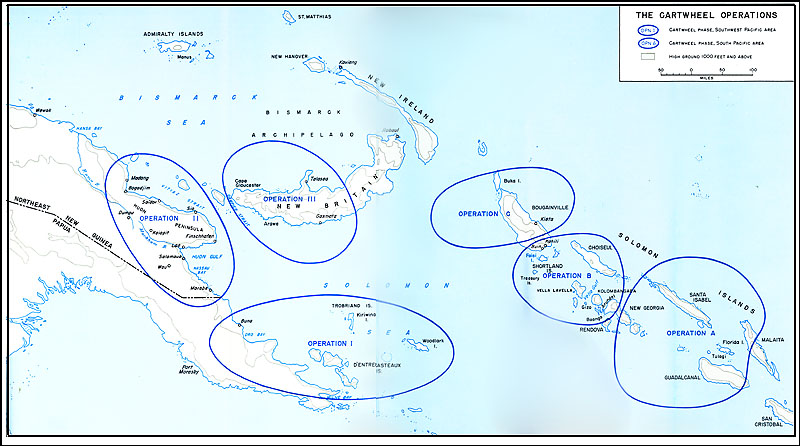
Once the Japanese withdrew from Guadalcanal, they moved to reinforce their bases around New Georgia, particularly the airbase at Munda Point. They also built another one of the very close by island of Kolombangara at Villa to support it. Henderson Field was too far away to support attacks against Munda, and there were too few carriers to support the attacks in the Solomons as well- they were going to have to support invasions in the Central Pacific. So, the Allies had to build bases in order to support attacks on Munda. The Russel Islands between Guadalcanal and New Georgia, would be perfect, but had to be cleared of Japanese troops. In February of 1943, the Allies invaded the Russels, and swept the small Japanese garrison aside. Over the next few months, they built several airfields, a small port, and a large collection of supplies to invade New Georgia, in spite of repeated Japanese air attacks. Once these bases were complete and running in May, they could support TOENAILS, the actual attack on New Georgia and Munda Point. During all of this, the Navy launched a series of raids against Munda and Villa, bombarding the airfields and harassing the Japanese there.
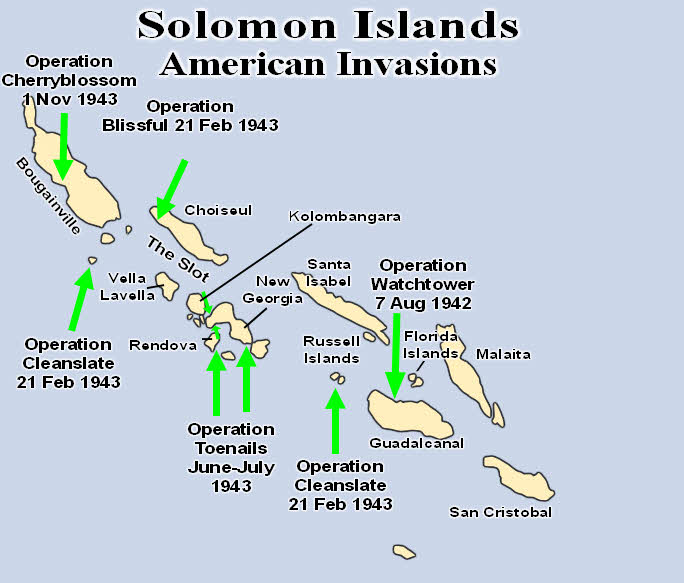
The Allies planned a series of landings at the end of June, 1943. One landing would secure Wickham Anchorage as a naval base for further attacks in the area. Another would land on Rendova Island, which was within artillery range of Munda Point, and would allow support for attacks against it. The third would land at Segi Plantation, where a large Japanese army base would threaten the rear of any direct landing against Munda. Despite the usual slipups- troops landing at the wrong beaches, commanders not sure quite where to go- these landings proved successful, and captured their objectives. On July 5th, another landing made its way to the northern coast of New Georgia, with the intention of cutting the line between Munda and Villa, but the offensive ultimately stalled in the deep jungle.
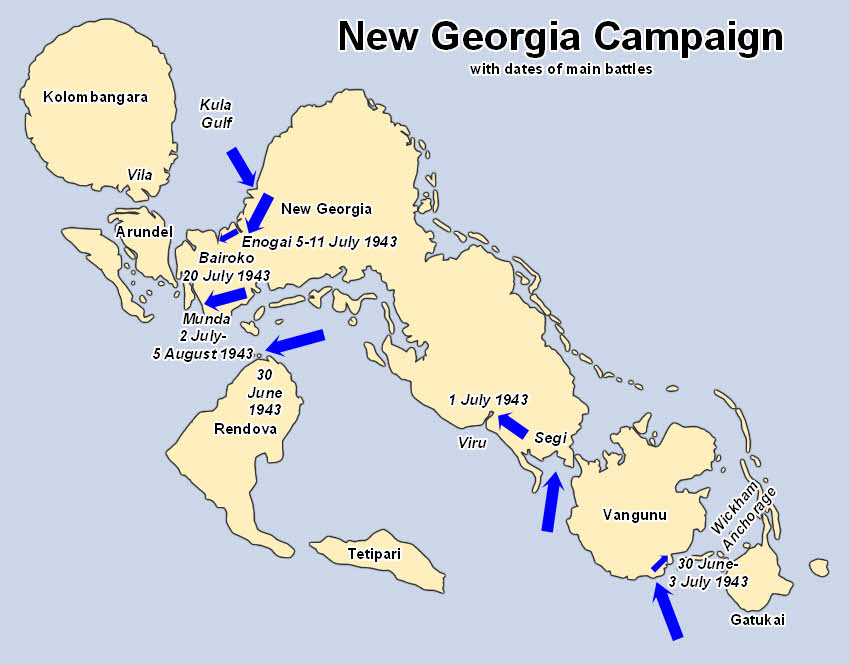
The main landings against Munda came on July 5th. The most direct beach to Munda was Laiana Beach, but was heavily defended by Japanese forces, including men from the Special Naval Landing Force, and fortified with nearly a year’s work. Rather than run into the teeth of those defenses, the Americans decided to land a few miles away at Zanand beach, which was well within the range of naval gunfire support and artillery on Rendova Island. From there, the Americans would march through the jungles of New Georgia to Munda, then capture the airfield.
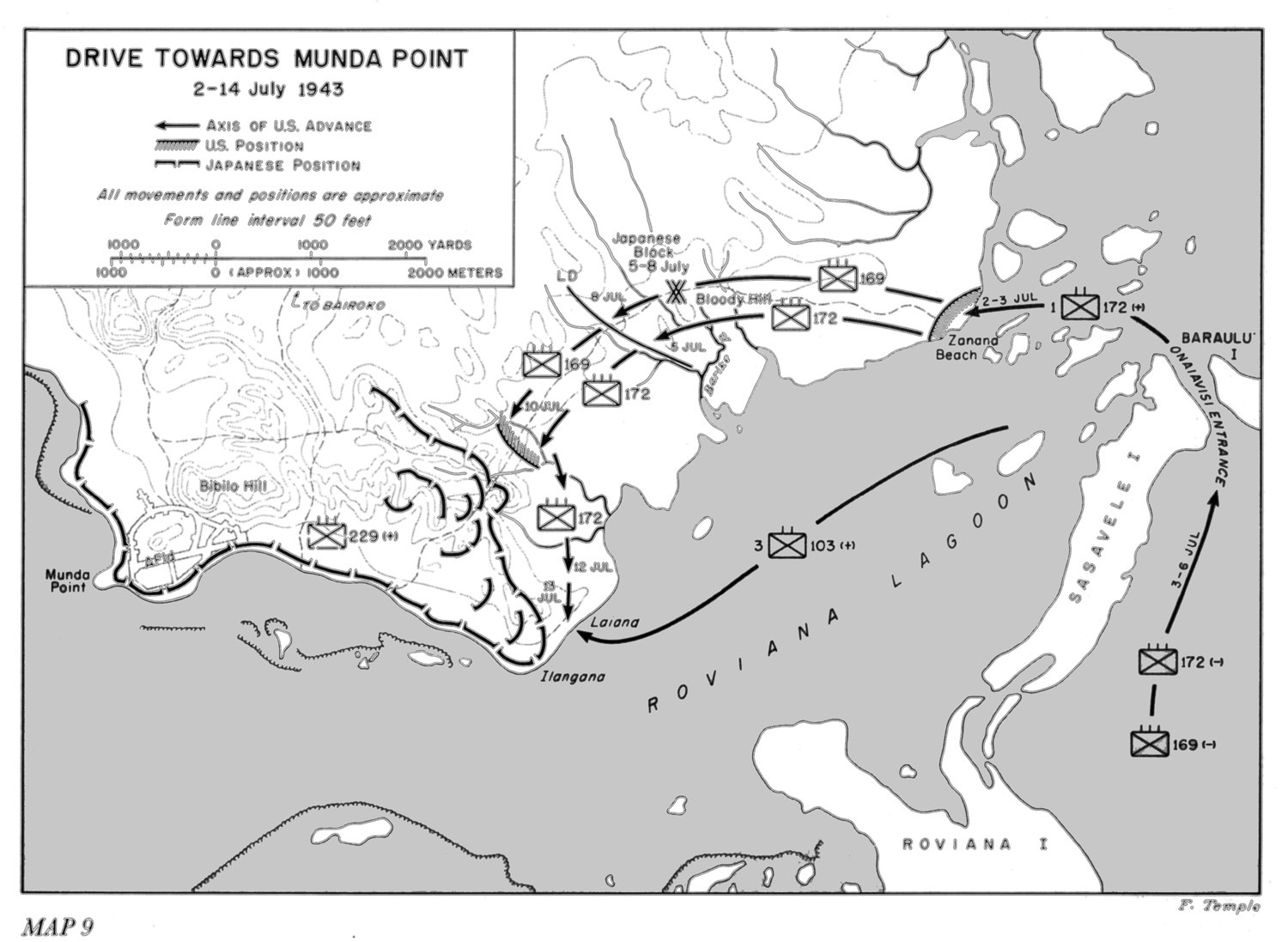
This proved quite difficult, in the end. Despite months of training, the troops that landed found the going very difficult. The jungles of New Georgia were dense, poorly mapped, unimproved and all around difficult. The going was quite slow, and the Japanese proved adept at slowing the American advance. Japanese infiltrators in the night induced American troops to shoot at each other. Navigation difficulties made attacks against Japanese blocking forces uncoordinated, and other troubles made the advance much slower than anticipated.

The Battle for Munda
The first major attack against the Japanese defenses around Munda began on July 9th. Poor intelligence made most of the early attacks difficult, as supporting artillery and air attacks bombarded empty jungles, and US troops struggled to find their objectives. The weather refused to cooperate over the course of the next few days, limiting air support, while aggressive Japanese patrols and ambushes forced the Americans to move cautiously. Suppling troops through the jungle proved difficult, and evacuating the wounded and sick proved even harder. While the Americans did manage to secure Laiana Beach for further reinforcments on July 13th, the men of the 43rd Division, carrying out the attacks, were mostly depleted by the tough marching and fighting, and would need a rest to continue the attacks against the actual Japanese defenses- defenses that had received nightly reinforcement and supply since the invasion began.

On the night of the 17-18th, the Japanese launched a massive counterattack against the weakened American forces. This attack broke through to the rear of the American forces, bringing the hospital, engineers and division headquarters under attack. The attack was furious, and only defeated by massive artillery support and coordination from all across the surrounding islands. However, in spite of the defeat of the Japanese attack, the American commanders in the region decided to make some serious changes to the forces on New Georgia. The 37th Division landed, and moved towards the American right, while other elements from the 25th Division also landed. The rest of the XIV Corps assets also landed, which made a significant change in the ability of the Americans to provide logistical and medical support to the troops.
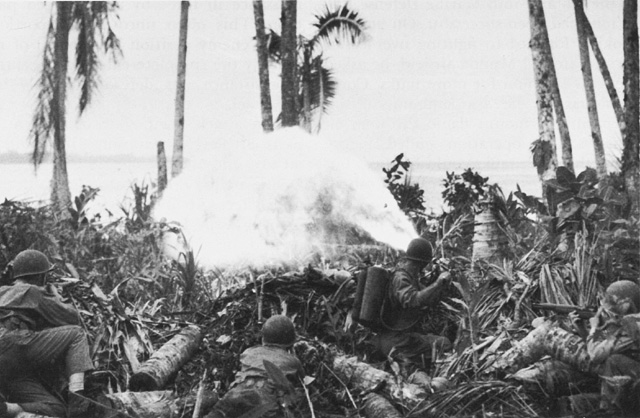
It wasn’t until July 25th that the Americans were ready to renew the attack. This time, the Americans had a better sense of where the Japanese were, and how best to make the attacks against the strong Japanese fortifications. Using tanks to support the attacks, and with stronger air support, the Americans made some progress against the Japanese over the next several days. In particular, the 37th Division moved against Horseshoe Mountain, a U shaped mountain at the northern end of the line. The attacks took several days, but, by August 1st, the Americans finally broke through the ring of defenses around Munda, and swept towards the airfield on the 2nd.

The Japanese decided to make one last stand at the airfield itself. Taking to the hills around the field, the remaining defenders held out as the 37th Division moved north of the field to encircle it on the 3rd. On the 4th and 5th, the 43rd assaulted across the airfield, while the 37th attacked the defenses to the north- by the end of the 5th, the airfield was in American hands, and the 37th spent the next couple of days rounding up the fleeing Japanese as they tried to get away from the collapse of the defenses.
Further reinforcements would come, and help support the mopping up on New Georgia itself. Further attacks also came against Kolobamgora, Vella Lavella, and other islands in the area. Fighting continued until October of 1943, when the Japanese evacuated their last forces from the island.
Out of 30,000 men committed by the Allies, 1200 died, while 1600 of 10,000 Japanese committed to the island died. Many more suffered wounds or disease, of course.
After the battle, the 37th returned to Guadalcanal, to train and prepare for Bougainville.
